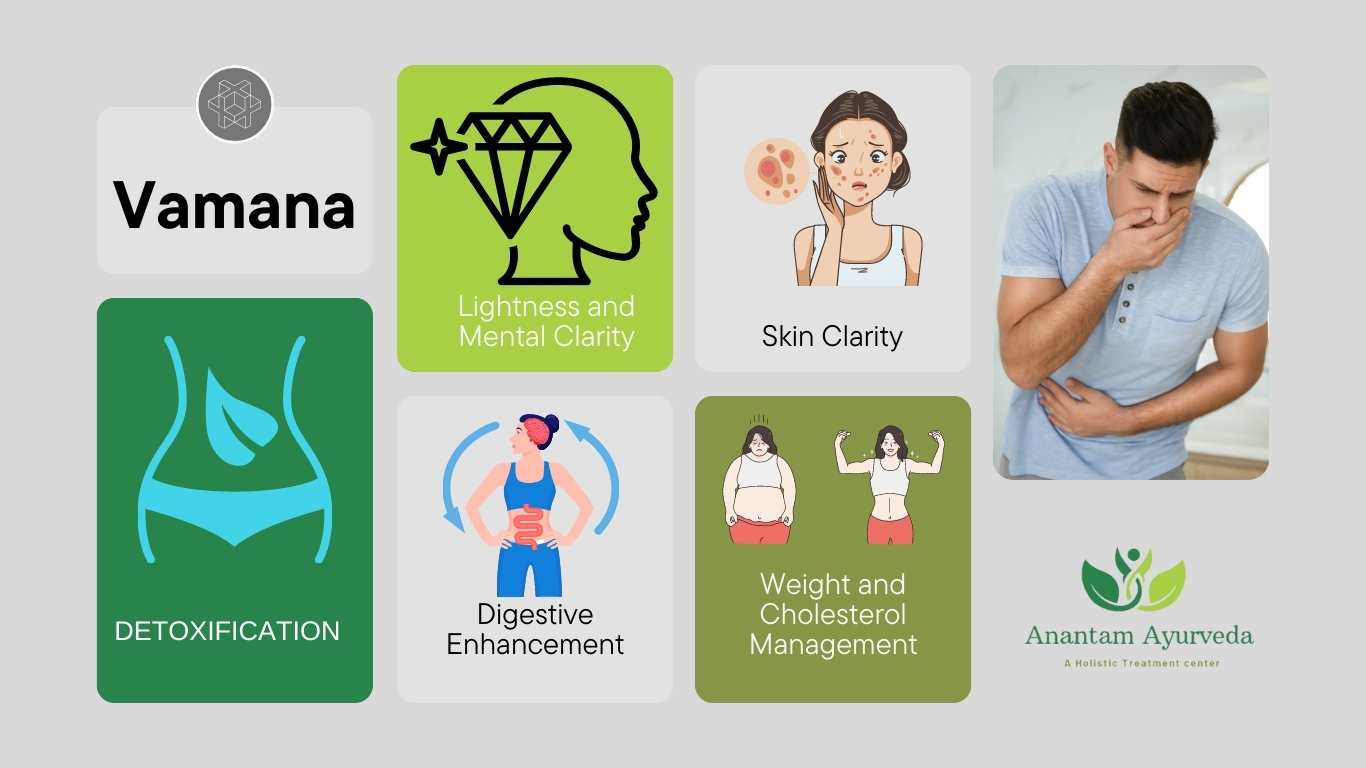Vamana: Cleansing through Therapeutic Vomiting
Introduction
Vamana Karma, an integral aspect of Ayurvedic Panchakarma, brings forth a unique approach to wellness that has intrigued and captivated health enthusiasts for centuries. Rooted in the principles of Ayurveda, It refers to a therapeutic vomiting technique performed using medicated emesis. This procedure addresses the aggravated Kapha dosha, promoting the expulsion of toxins from both the respiratory and gastrointestinal systems. The practice serves both curative and preventive purposes, offering a pathway to holistic health and balance.
Understanding Vamana: An Ancient Art of Cleansing
Historical Roots and Cultural Significance
Vamana, also known as “Vamana Karma,” holds a significant place in the ancient Ayurvedic texts, dating back thousands of years. The term “Vamana” itself translates to “vomiting” in Sanskrit, highlighting the central aspect of this practice. Ayurveda, which translates to “science of life,” emphasizes the importance of maintaining balance among the body’s three doshas: Vata, Pitta, and Kapha. Vamana is a key component of Panchakarma, a comprehensive cleansing and rejuvenation therapy within Ayurveda. Its primary objective is to pacify the aggravated Kapha dosha, a vital bioenergy responsible for stability, lubrication, and structure within the body. The Vamana procedure achieves this by facilitating the expulsion of excessive Kapha, thereby alleviating associated imbalances and discomforts.
Seasonal Relevance
Ayurveda holds that different seasons influence the dosha balance within the body. In this context, Vamana’s timing becomes significant. As Kapha tends to increase during the spring season (Vasant), adopting Vamana therapy during this period can act as a preemptive measure against Kapha-related disorders. This preventive approach underscores Ayurveda’s holistic philosophy, emphasizing the importance of harmonizing the body with nature’s rhythms.
Methodology: The Process of Vamana
Preparatory Phases: Snehan and Svedan
Prior to the actual Vamana procedure, the patient undergoes two preparatory phases: Snehan and Svedan. Snehan involves oleation therapy, wherein medicated oils are ingested to enhance the body’s internal lubrication. Svedan follows, where the patient undergoes induced sweating to further prepare the body for the forthcoming therapy.
The Vamana Procedure
The Vamana procedure commences with the administration of 3-4 glasses of saltwater infused with licorice. This aids in inducing nausea and vomiting, facilitated by the gentle scraping of the tongue. Notably, we recommend fomentation and oil massage the night before the procedure, along with consuming a specific quantity of the recommended oil. This encourages the stool to become oily, indicating readiness for the therapy.
Benefits of Vamana
It is renowned for its potential benefits that extend beyond mere physical cleansing. Some of the notable advantages of this therapy include:
- Detoxification: By expelling accumulated toxins from the body, it contributes to improved overall health and vitality.
- Lightness and Clarity: Following Vamana, individuals often experience a sense of lightness within the chest and enhanced mental clarity.
- Digestive Enhancement: The process of therapeutic vomiting is believed to reset the digestive fire (Agni), promoting better digestion and metabolism.
- Weight and Cholesterol Management: It aids in weight loss and the reduction of cholesterol and triglyceride levels.
- Balancing Doshas: It assists in harmonizing the three doshas, which is vital for maintaining optimal health and preventing ailments.
- Skin Clarity: Individuals often report improved skin complexion and radiance after undergoing Vamana therapy.
- Respiratory Health: We believe that Vamana benefits those with respiratory disorders, as it clears congestion and promotes respiratory well-being.
Post-Therapy Care
Following the procedure, we recommend complete rest and a light diet. Fasting is often suggested to allow the body to recover from the intensive detoxification process.
Precautions and Considerations
While Vamana Karma offers a plethora of benefits, certain precautions must be observed. This therapy is not suitable for children under 12, individuals above 65, pregnant women, and those during menstruation. Sensitive individuals experiencing fear, anxiety, or anguish should also exercise caution. Additionally, individuals should undertake it only under the guidance of a qualified professional to ensure safety and proper execution.
Conclusion: Embracing an Ancient Path to Wellness
In a world where modern medicine and wellness practices often dominate the landscape, ancient traditions like Vamana offer a unique and profound perspective on holistic health. Through its carefully structured methodology and emphasis on detoxification, it provides a pathway to internal harmony, physical well-being, and mental clarity. As individuals continue to seek alternative avenues for health and healing, it stands as a testament to the timelessness and wisdom of Ayurvedic principles.
Incorporating the practice of Vamana into one’s wellness journey requires thoughtful consideration and expert guidance. By acknowledging its historical significance, understanding the methodology, and recognizing the potential benefits, individuals can make informed decisions about whether it aligns with their personal health goals. As we navigate the complex world of health and healing, embracing the wisdom of the past can pave the way for a brighter, more balanced future.
To embark on a journey of holistic cleansing and rejuvenation, consider exploring the therapeutic practice of Vamana with the guidance of a seasoned Ayurvedic practitioner. Unlock the potential of ancient healing techniques and experience the transformative power in your pursuit of optimal well-being.
You can follow us on twitter, facebook, instagram & Google News

1 Comment